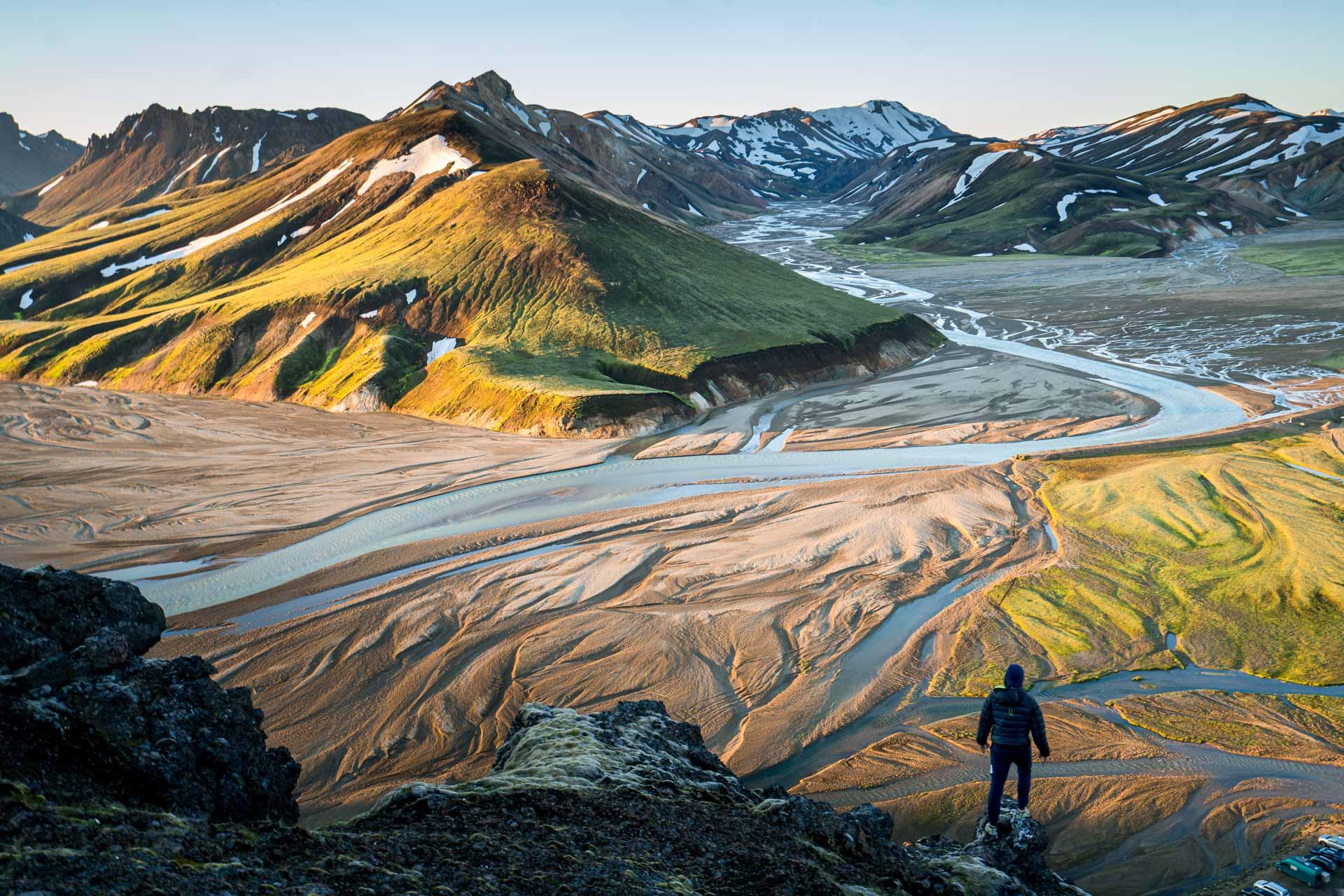Iceland's Highest Peak, Hvannadalshnukur
| All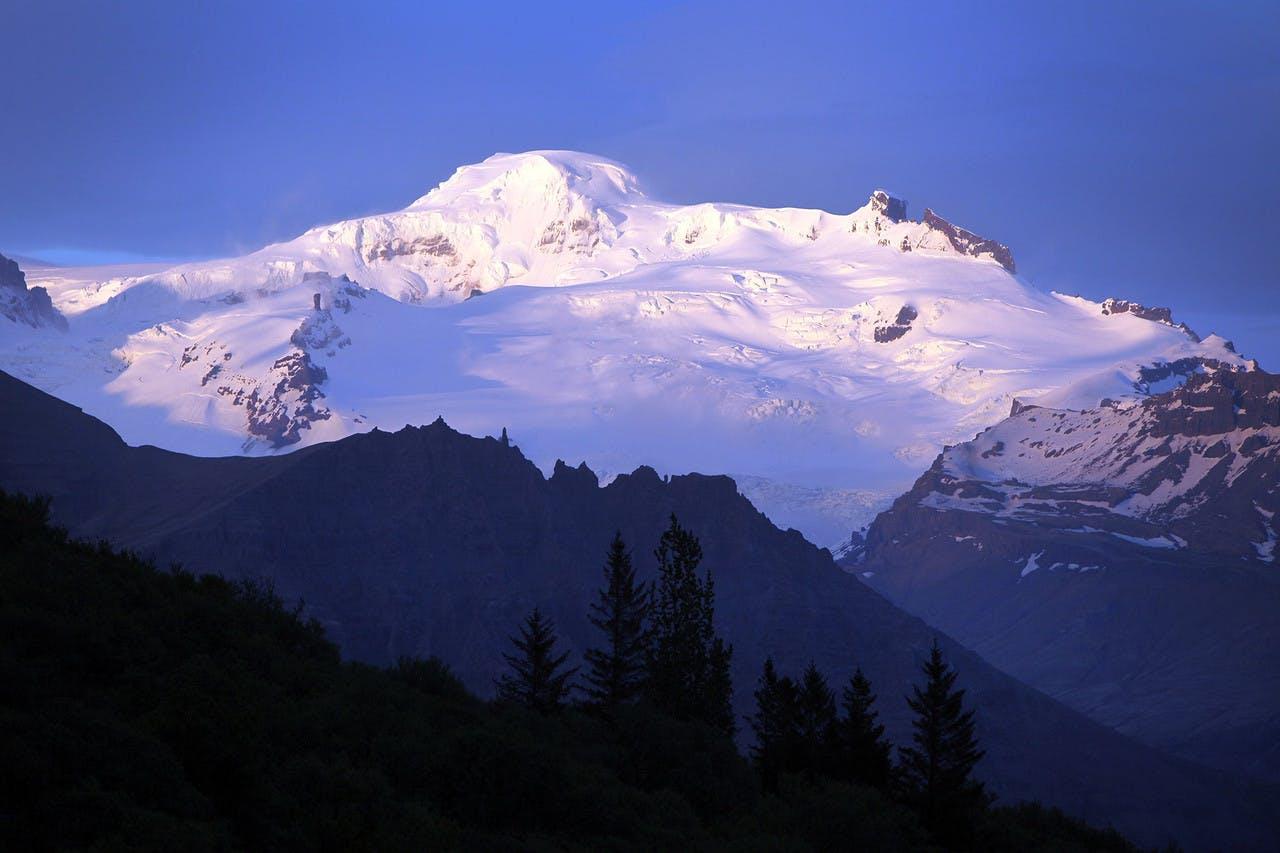
Hvannadalshnjúkur
Table of Contents
Hvannadalshnjukur, the tallest mountain in Iceland, is an unforgettable experience for the intrepid mountaineer or any experienced hiker wanting to push themselves out of their comfort zone… onto Iceland's highest point. Climbing Hvannadalshnjukur is a thrilling challenge requiring fitness, stamina, and a thirst for adventure. In a country of towering mountains of dazzling beauty and presence, the ice-capped Hvannadalshnjukur is the icing on the cake… excusing the pun.
Where is Iceland's highest peak located?
The dome-shaped Hvannadalshnjúkur peak is a dramatic landmark located on the glacier-topped volcano, Öræfajökull in southeast Iceland. It’s not just the highest point on the crater rim; it’s also the highest point in the whole of Iceland.
Found on the edge of Vatnajökull National Park, Hvannadalshnjukur is part of the Mid-Atlantic Ridge. Its towering hulk is visible from many places, particularly along the Ring Road between Höfn and Vík.
The Mid-Atlantic Ridge is a massive underwater mountain range running through the Atlantic Ocean's centre from north to south. It marks the boundary between the North American Plate and the Eurasian Plate in the north and the South American Plate and the African Plate in the south. The ridge rises above sea level in Iceland, and Hvannadalshnjúkur is the highest point on this ridge section.
When the sun gleams on the massive ice-covered peak, it’s a stunning sight within the landscape. While Hvannadalshnjukur is not a particularly difficult technical climb, the weather is notoriously challenging on the glacier. There, crevasses abound, unexpectedly forming and constantly changing shape. Guided climbs are highly recommended unless you’re summiting alongside a team of experienced glacier climbers.
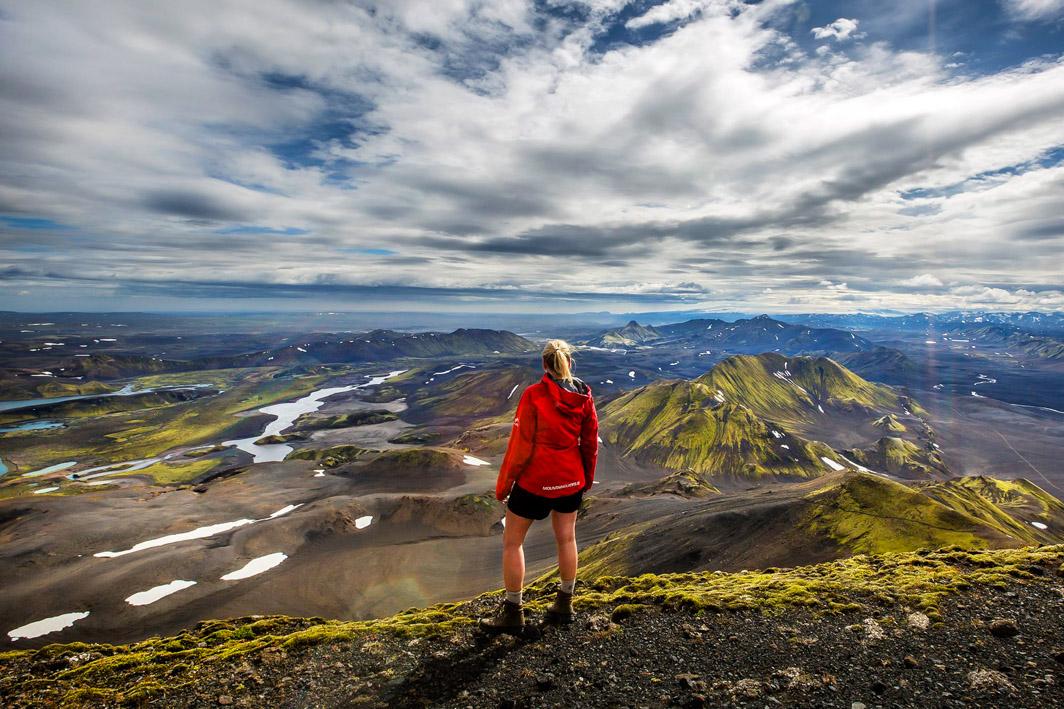
The Ultimate Guide to Hiking Iceland
The Ultimate Guide to Hiking Iceland tells you everything you need to know about trekking in Iceland:
- Where to find the best hikes in Iceland
- Distances and high points
- Stunning single and multi-day hikes
- Elevations
- Accommodation and food
Find out what you’ll see on the way, from colourful valleys, black lava fields, and soaring mountains to dazzling glaciers. Discover a hike that suits your needs; visit Iceland’s disappearing glacial landscapes and its most beautiful mountains, valleys and coasts.
Formation and history of Iceland's highest peak
The volatile area of Iceland where Hvannadalshnjukur finds itself has a long recorded history of disruptive volcanic activity. Vatnajökull has had five recorded eruptions: 1362 (resulting in massive destruction), 1727, 1996, 1998 and most recently in 2004. It’s a landscape that has been constantly in flux, where volcanic eruptions and glacial activity have shaped and reshaped mountains and valleys. Hvannadalshnjukur is part of this shape-shifting, awe-inspiring geology. Luckily, the Öræfajökull area is currently free of volcanic activity, meaning tackling this thrilling mountain is safe.
Historically, the first documented ascent of Hvannadalshnjukur occurred on August 17, 1891, when British man Frederick W. W. Howell was guided up by locals Pall Jonsson and Thorlakur Thorlaksson. The iconic mountain has provided challenging climbing ever since.
The good news is that guided expeditions open up the mountain to anyone with good fitness and stamina and some experience in mountain climbing. Because you’ll be hiking over glacial terrain, you’ll need to be roped and led by guides experienced in glacial walking - with a knowledge of safe routes through the minefield of crevasses.
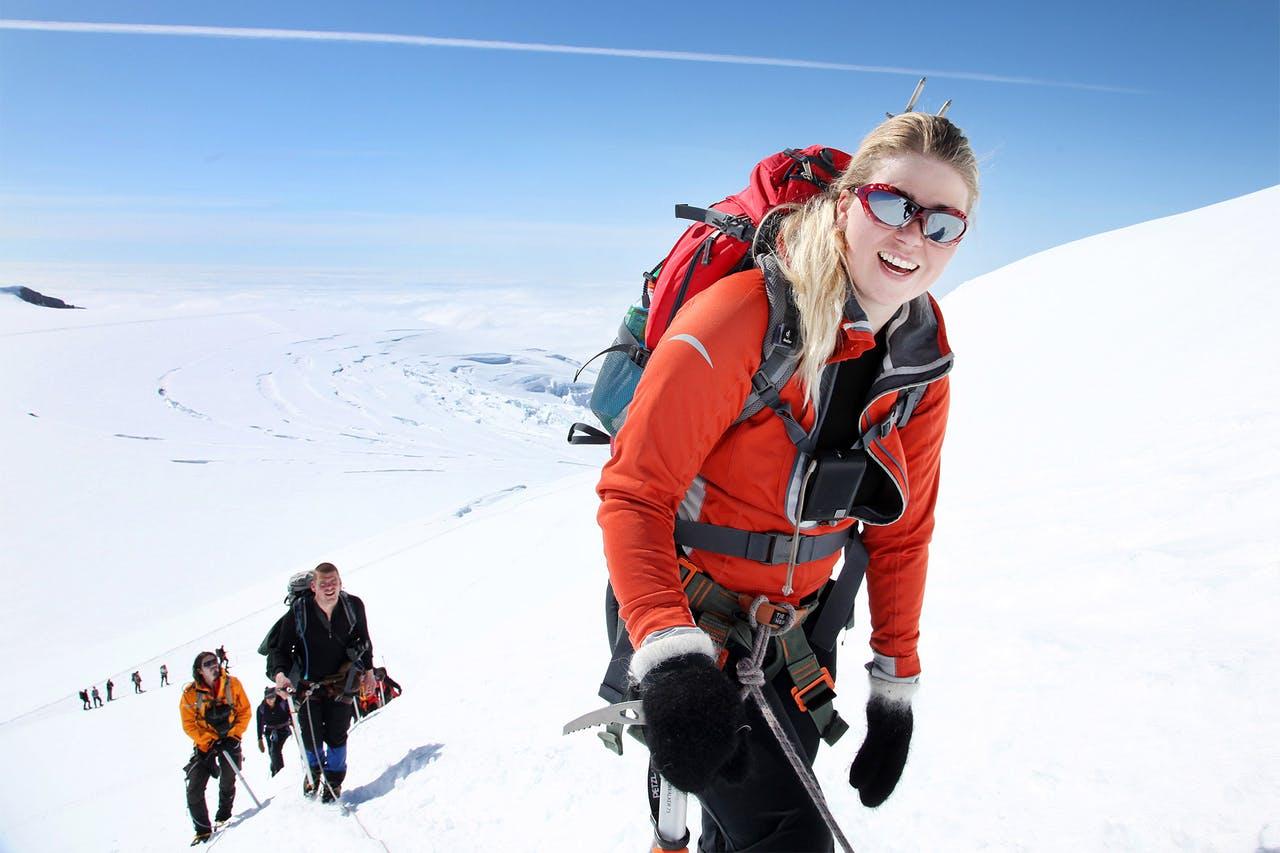
Hiking up to Iceland's highest peak
Climbing Hvannadalshnjukur
Preparation for the climb
In challenging physical situations, whether it’s a competitive sport or high-level mountaineering, the right psychological attitude is paramount. While you must be realistic about your fitness and endurance levels, an I-can-do attitude makes all the difference. It’s no accident that psychological training is just as important as physical training for professional sportsmen and women.
Cardiovascular Training: Climbing a mountain requires a lot of cardiovascular endurance. You should include exercises like running, cycling, or swimming in your training routine to improve your cardiovascular fitness. Aim to gradually increase your time and intensity as you progress in your training.
Strength Training: Building strength in your legs, core, and upper body is essential for climbing a mountain. Exercises like lunges, squats, calf raises, pull-ups, and push-ups can help strengthen these muscle groups.
Hiking: Hiking is an excellent way to prepare for climbing a mountain. Start with a smaller mountain, building up to around 1,000 m. If you’re in Reykjavik, Esja is a good training mountain. Recreate the conditions of your climb too. Increase the difficulty over time and try to find hiking trails with similar elevation gains as Hvannadalshnúkur.
As the Hvannadalshnjukur expedition includes a 12-hour ascent and descent (give or take), you’ll carry a daypack of around 5-10 kilograms. Bring a backpack of similar weight on your practice climbs, even if it’s not needed. Find a walking rhythm you can maintain for more extended periods. Set yourself goals to push yourself through your discomfort barrier. Summiting Iceland’s highest mountain is about endurance as much as fitness
Practice in Similar Conditions: Iceland's weather and terrain can be challenging, so practising in similar conditions is crucial. If you live in an area with cold weather, train outdoors in the winter to get used to the cold. If possible, practice climbing on rocky terrain or glaciers to simulate the conditions on Hvannadalshnúkur.
Rest and Recovery: Giving your body enough time to rest and recover between training sessions is essential. Incorporate rest days into your routine to allow your muscles time to recover and prevent injuries.
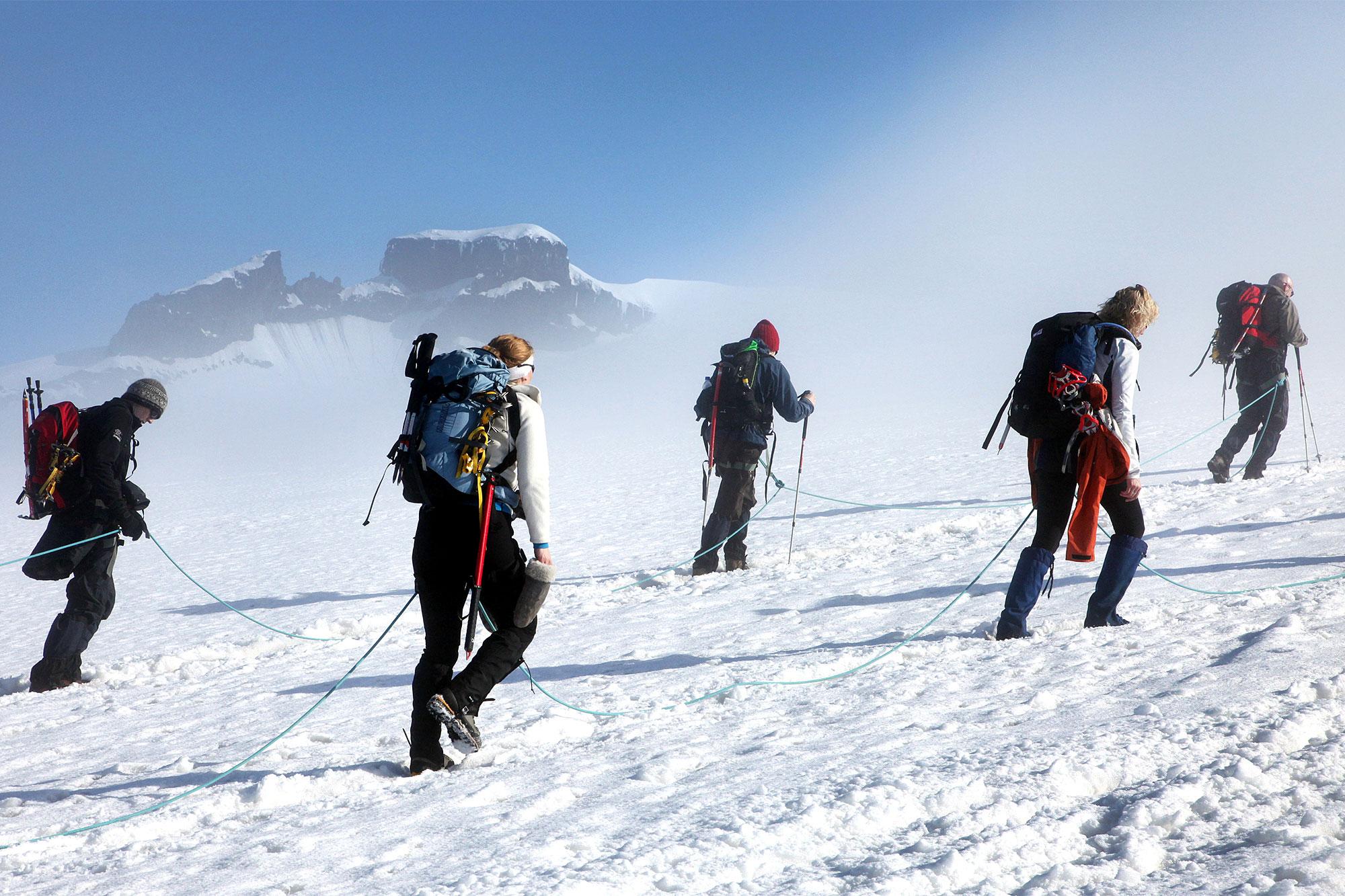
Hikers near the peak of Hvannadalshnjukur
Required equipment and gear
Having the right equipment for high-level climbing with glacial features is crucial, and it should be of good quality. Always check your equipment before setting out. For Hvannadalshnjukur, you’ll need the following:
- Crampons - the spiked attachments for your boots are necessary for gripping the ice and snow you’ll encounter
- Ice axe - crucial for balance and stability, as well as for self-arresting in case of a fall
- Harness - worn around the waist, it connects you to the rope and offers essential support on steep terrain
- Rope - strong and durable rope is pivotal for glacier travel and protection
- Helmet - A protective helmet is needed to guard against falling debris and to offer protection if you fall
- Gaiters - protective coverings go over your boots to keep snow and ice from dropping in
- The right clothing - dressing in layers and choosing clothing that can handle cold and wet conditions will keep you warm and dry
- Sunglasses - protect your eyes from direct sunlight and the glare of reflected snow
- Gloves - waterproof gloves protect your hands from the cold and the ice
- Backpack - big enough to carry all of your necessary gear and supplies
- Food and water - plenty of energy-giving food is required for the climb, along with water to stay hydrated
- GPS, map and compass - are needed to navigate the terrain and stay on course
When you opt for a guided tour, you'll receive all the essential safety equipment such as crampons, harness, rope, ice axe, helmet, GPS, and more. All you need to bring are appropriate clothing, footwear, and a reliable backpack.
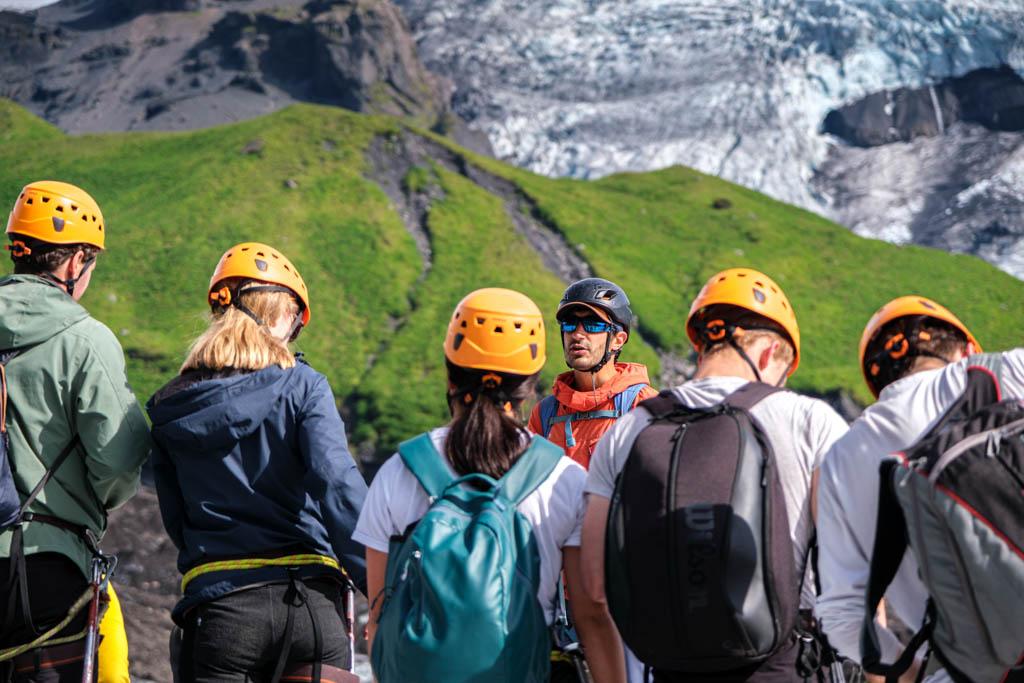
What to Wear on a Glacier Hike in Iceland
Wondering What to Wear on a Glacier Hike in Iceland but don’t know where to begin? This comprehensive list will guide you through the does and don’ts of glacier hiking in Iceland. Our ultimate blog doesn’t just tell you what to wear and the equipment you’ll need; it also tells you where to find the best beginner glacier hikes. We give you the lowdown on trips that combine glacier walking with ice-cave exploration, ice-wall climbing or even the highlights of the south coast. In fact, we highlight the best glacier tours Iceland has to offer.
Routes to the summit
There are two main routes to the summit of Hvannadalshnjukur, both starting from the western flank of the mountain. Both routes also gain around 2000 meters / 6600 feet of elevation, requiring a long day to conquer the mountain.
The Hryggjaleið route from the Virkisjökull glacier is only open until about mid-July and is then closed because of crevasses and icy surfaces. This route is highly challenging and dangerous; only professional mountain climbers can use it.
The standard - and more popular - Sandfellsleið route starts a bit further south from the parking lot at the foot of the mountain in the Skaftafell National Park. This route takes you up to the peak via the Svínafellsjökull glacier and involves glacier walking and some basic ice climbing. The latter route takes about 12 hours, approximately 8 hours up and 4 down. It’s open for most of the year.
The 2000m elevation gain and drop in one day make the climb one of the longest and toughest in the world offered by regularly operated commercial guiding operations. This is because the climb starts almost at sea level. On the plus side, after 2000m (over 6500 ft) of climbing, there is no detectable effect of thinning air as you’d feel in the Alps or other higher mountain ranges. It still requires climbers, however, to have good overall fitness and, even more importantly, stamina for a long day of strenuous climbing. Guided groups usually take around 12 hours to complete the entire climb of the mountain: 6-7 hours for the ascent and 4-5 hours for the descent.
Other routes require even more technical skills and experience, which are only recommended for experienced mountaineers.
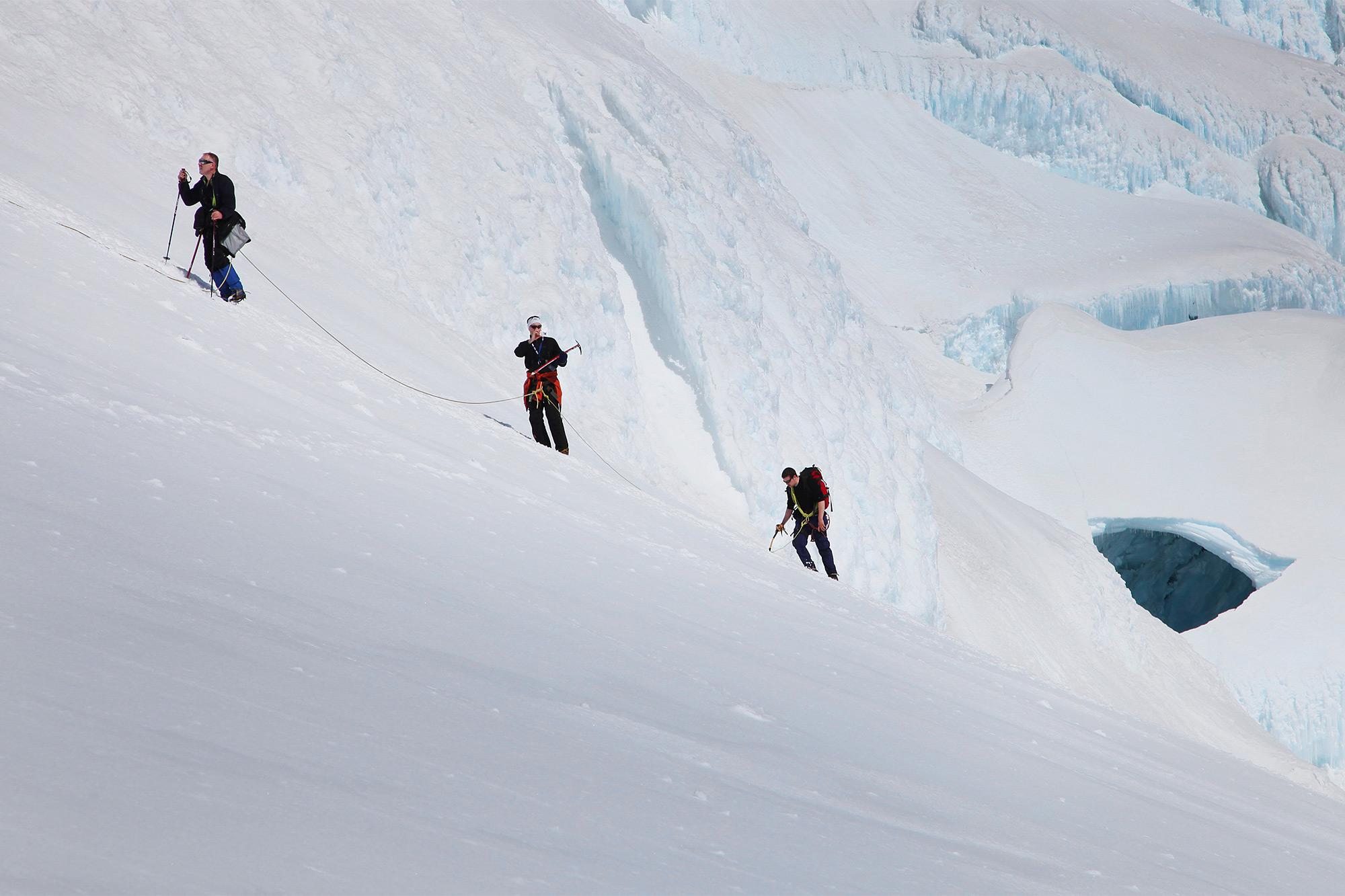
Three hikers going up the side of Hvannadalshnúkur mountain
Difficulty level and challenges
The climbing is strenuous - a physically and psychologically intense experience, only suitable for climbers with a high degree of fitness, focus and stamina. This is an expedition-level climb that’s challenging and demanding.
Furthermore, if you choose to climb the mountain independently without the assistance of local professionals, you must possess the necessary skills to use climbing equipment safely and confidently on steep mountainous terrain and glacial surfaces covered with snow. However, if you opt for a guided tour, all necessary equipment will be provided, and a trained guide will ensure your safety.
Safety considerations
Ensure you are appropriately dressed for the changeable weather and cold and windy conditions - wear layers with a thermal underlayer, sturdy waterproof boots and a jacket. Add a hat and gloves. Carry a compass and map.
Check the weather before setting out. Download safetravel.is app for up-to-date weather reports and road and trail closures. The highlands are prone to snow and ice, and many hiking trails are out of bounds in winter.
Only climb the mountain with trained mountaineers who are experienced in high-level climbing, know how to use climbing equipment, and are skilled in climbing through ice and snow and traversing glaciers with crevasses. This is not a mountain to climb solo.
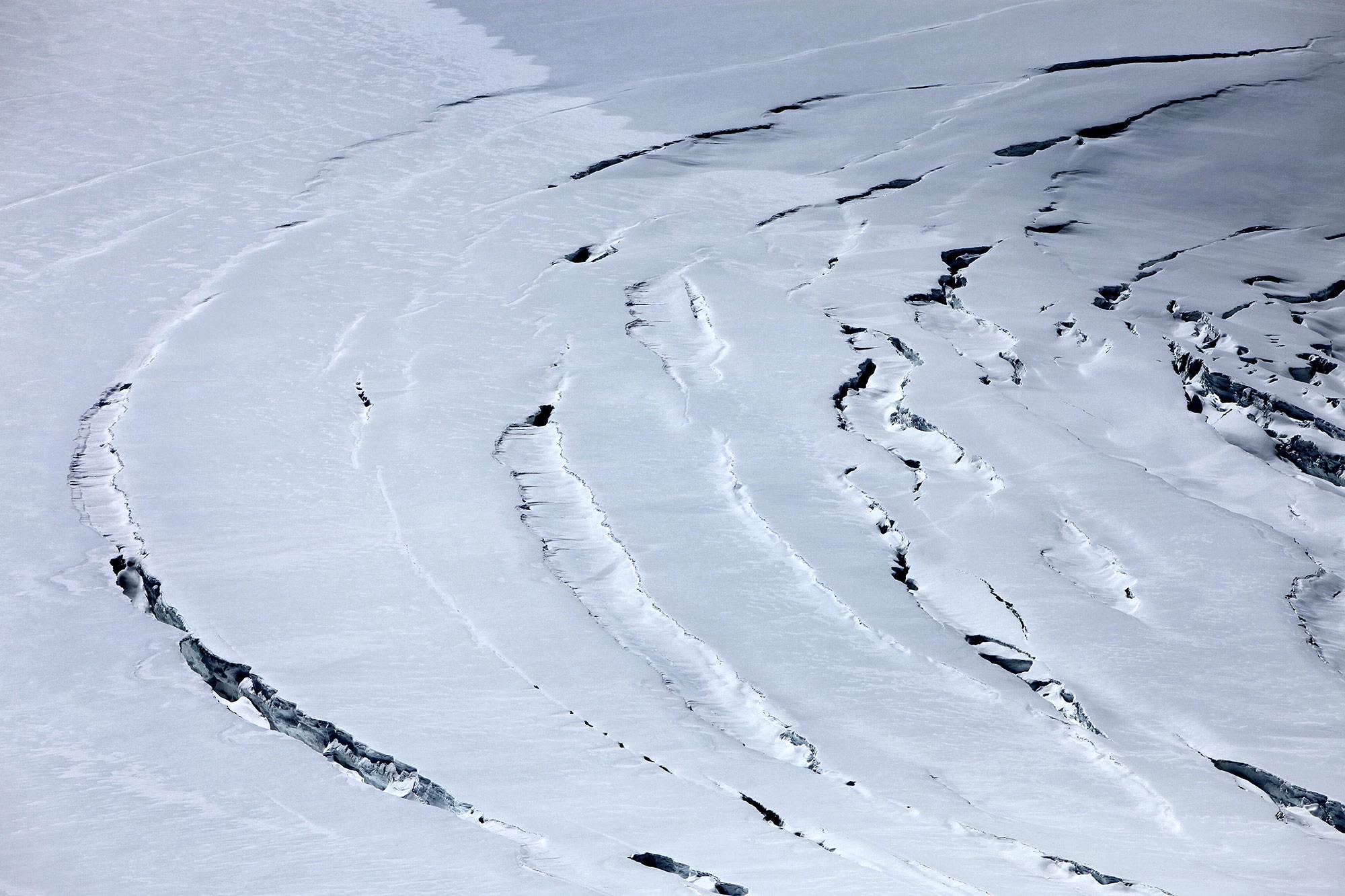
Glacial crevasses near the peak
Panoramic views from the highest peak of Iceland
As you’d expect, you can see for miles in every direction on clear days. The panoramic views take in the stunning landscapes of southeast Iceland. Looking north, you'll see the vast Vatnajökull glacier, the largest glacier in Iceland and one of the largest in Europe. The glacier is surrounded by rugged mountains and deep valleys, creating a dramatic backdrop to the already stunning scenery in your immediate surroundings.
To the east, you'll see the Atlantic Ocean, stretching out as far as the eye can see. To the south, you'll see the famous black sand beaches of the coast and the small town of Höfn. All around it are towering mountains contrasting the rugged coastline.
On a clear day, you may even be able to spot the Westman Islands, a small archipelago located off the southern coast of Iceland. Finally, to the west, you'll see the highlands of Iceland, home to some of the country's most remote wilderness. The highlands are dotted with glaciers, volcanic craters and vast expanses of moss-covered lava fields, creating a unique and awe-inspiring landscape.
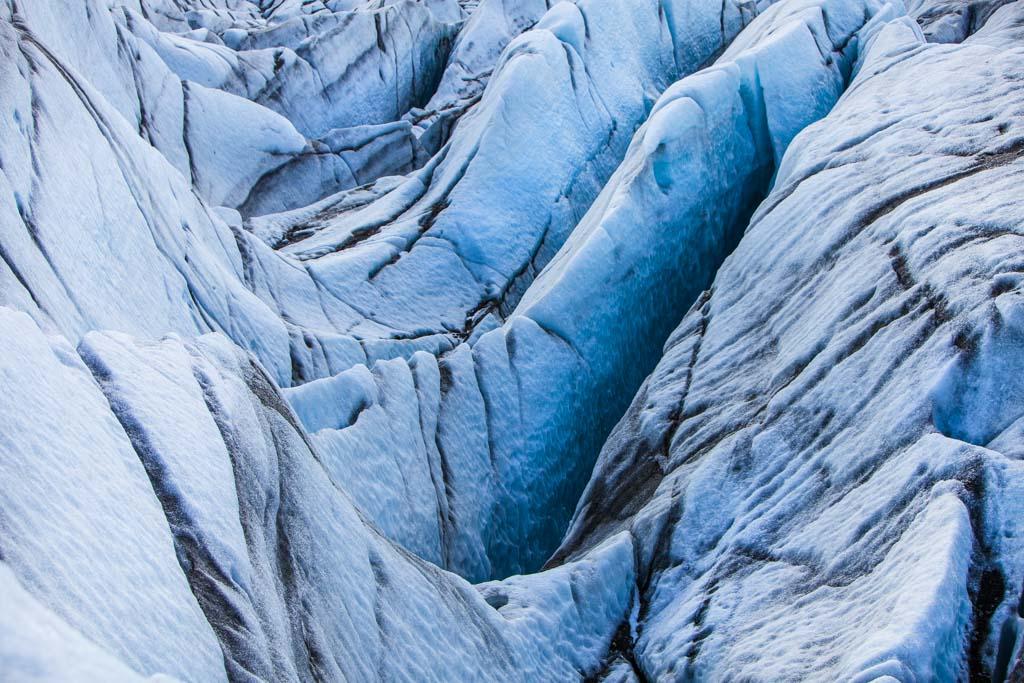
Ultimate Guide to Glaciers and Glacier Hikes in Iceland
So you’re trying to get your head around the language of glaciology. Crevasses? Moulins? Outlet glaciers? Ice tongues? Don’t worry; in this Ultimate Guide to Glaciers and Glacier Hikes in Iceland, we’ll talk you through the terminology, and we promise you it won’t be a boring geography lesson. The formation of glaciers over aeons is one crazy story. Once you’ve discovered how glaciers come about, find out where you can:
- tackle an easy first-time glacier walk
- snow-mobile on a glacier
- explore a blue ice cave
- Ice-climb
- Combine a glacier walk with south coast highlights
Hvannadalshnjukur in the Icelandic Culture
Myths and legends
In Icelandic mythology, the giantess Hrungnir was buried under Hvannadalshnjukur after being defeated in battle by the mighty Thor, the Norse god of thunder. The mountain is believed to be her tomb, and her enormous heart is said to be preserved in a nearby cave. The story is a part of Icelandic mythology found in ancient texts such as the Prose Edda and the Poetic Edda.
History
The mountain is likely to have been an important landmark for early settlers in Iceland. This focal point helped them orient themselves, navigate the rugged terrain, and establish settlements. The area around the mountain is rich in archaeological sites, including the ruins of ancient farmsteads and burial mounds.
Role in modern Icelandic society and tourism industry
Hvannadalshnjukur holds a special place in the hearts of Icelanders, the rugged giant surrounded by beautiful landscapes. Located within Vatnajökull National Park, the largest national park in Europe and one of Iceland's most important national treasures, the area is home to a wide variety of plant and animal species, including reindeer, arctic foxes, and numerous bird species.
Not surprisingly, it attracts thousands of visitors each year. The great hulk of mountain, covered in snow and ice is also located within the mighty Vatnajökull ice cap and has played an important role in shaping Iceland's landscape. It's a symbol of the country's incredible natural beauty and power.
Climbing its summit is often seen as a rite of passage for Icelanders and increasingly so for visitors seeking to explore the country's untamed wilderness. It is, in short, a beacon of aspiration in Iceland's outdoor culture.
Not only is climbing the mountain a thrilling challenge and a rewarding experience, but the views on the hike of the surrounding glacier and the broader landscapes of Iceland are also breathtaking. As an essential part of Iceland's tourism industry, Hvannadalshnjukur generates revenue for the country and provides employment opportunities for local communities.
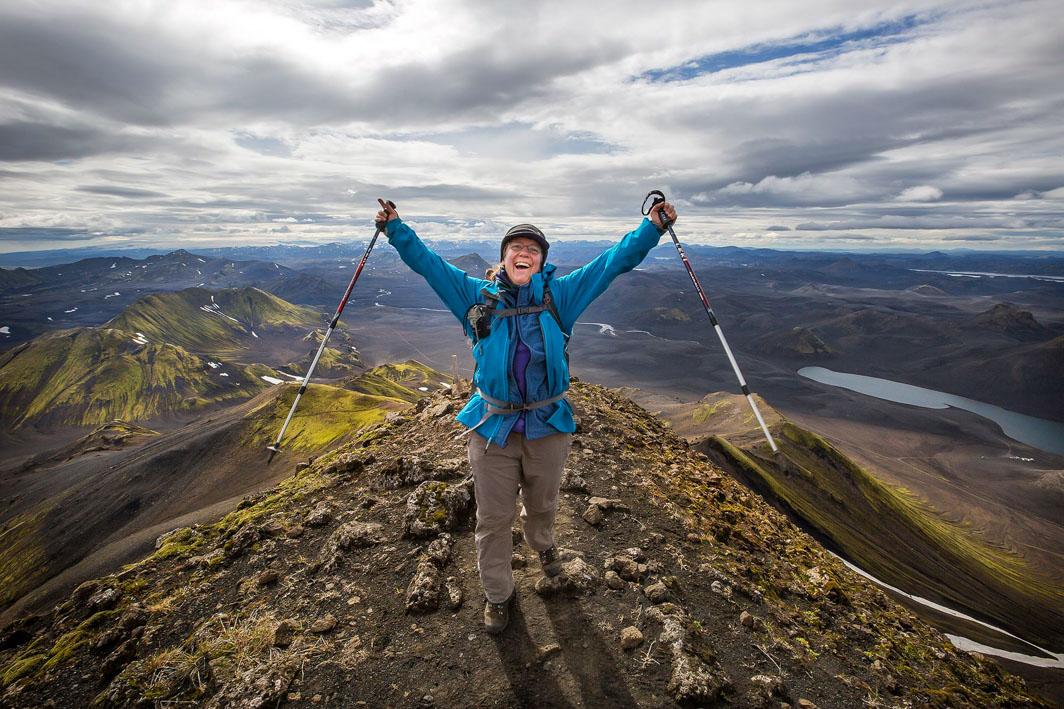
Complete Guide to Solo Hiking in Iceland
Is it a good idea to solo hike in Iceland? You bet! Go it alone and completely submerge yourself in Iceland’s thrilling landscapes without distractions. This Complete Guide to Solo Hiking in Iceland will explain everything you need to know. And if it still feels overwhelming, Icelandic Mountain Guides will organise everything you need for your trip, including public transport, car hire, accommodation and route maps.
An ascent of Hvannadalshnjukur is bound to be the high point on any trip to Iceland - excusing another pun! When you walk across the blues and whites of the sky and ice-covered mountains, it feels as if you’re floating high above the Earth, the extraordinary landscapes of Iceland at your feet.
Hvannadalshnjukur, the tallest mountain in Iceland, is increasingly the go-to mountain for visitors with a desire for a thrilling adventure with some high-level hiking experience under their belt. But whether you want to conquer Hvannadalshnjukur’s summit, admire it from a distance or hike its lower slopes and surrounding paths, Iceland’s highest mountain offers something for everyone.
Questions and answers about Iceland's highest peak
Still have some questions about Iceland’s highest summits and high-level hikes? Here’s an at-a-glance Q&A of common queries.
What is the tallest mountain near Reykjavik?
Visible from many parts of Reykjavik, Mount Esja, at 914 m (2999 ft), is the highest local mountain. Esja provides many beautiful hiking trails around its base, and a rewarding summit climb with a view over Reykjavík and Faxaflói bay.
How tall is the highest mountain in Iceland?
At 2,110 m (6,923 ft) Hvannadalshnjukur is the highest mountain in Iceland, with Bárðarbunga coming in second at 2,000 m (6,562 ft).
Is Iceland at a high elevation?
The highlands of Iceland cover about 40% of the country - areas over 500 m generally. On average, Iceland lies at an elevation of 557 m (1,827 ft). These wilderness areas, mostly uninhabited, make for thrilling hiking and climbing.
Do you get altitude sickness in Iceland?
That’s the beauty of Iceland: the elevations of its highest glaciers and mountains are still too low to cause altitude sickness, but the country still provides world-rate hiking and climbing experiences.
What are the three highest peaks in Iceland?
After Hvannadalshnjukur and Bárðarbunga, Kverkfjöll comes in third at 1,764 m (5,787 ft).
What is Iceland’s most famous trail?
The 55 km (34 mile) long Laugavegur Trek is Iceland's most famous hiking trail. No wonder: it meanders through landscapes of black lava fields, hot springs, colourful rhyolite mountains, bright green valleys of moss and jagged peaks.
What is the hardest climb in Iceland?
It may not be the most technically difficult climb in Iceland, but Hvannadalshnjukur certainly requires hardcore stamina and fitness. Starting from sea level, there’s a more than 2,000 m brutal ascent of the mountain - 12 hours of up and down over difficult terrain.
If you want to combine some of Iceland’s most challenging mountains, how about Iceland’s very own ‘Three Peaks Challenge’? Tackle three of Iceland’s most iconic mountains: Vörðuskeggi at 805 m, Eyjafjallajökull at 1651 m, and, of course, Iceland’s highest peak, Hvannadalshnjukur.
What is the most difficult hike in Iceland?
Again the multi-day Laugavegur Trek demands stamina and fitness to tackle the high-level hike through challenging terrain. There are lots of ascents and descents to contend with. Factor in the ever-changing and challenging weather conditions of Iceland’s highlands and you get the picture. But with spectacular vistas, the rewards more than outweigh the challenges.
Keep me informed about the Icelandic Mountain Guides Blog
Outdoor adventure in Iceland is our specialty. Subscribe to our free monthly newsletter to learn when to go, what to do and where to have the best adventures in Iceland.


